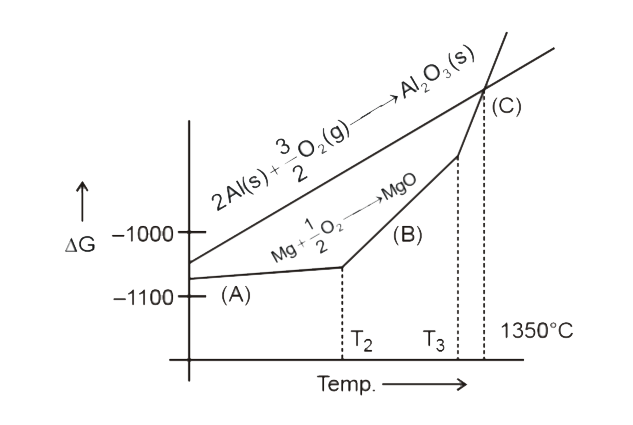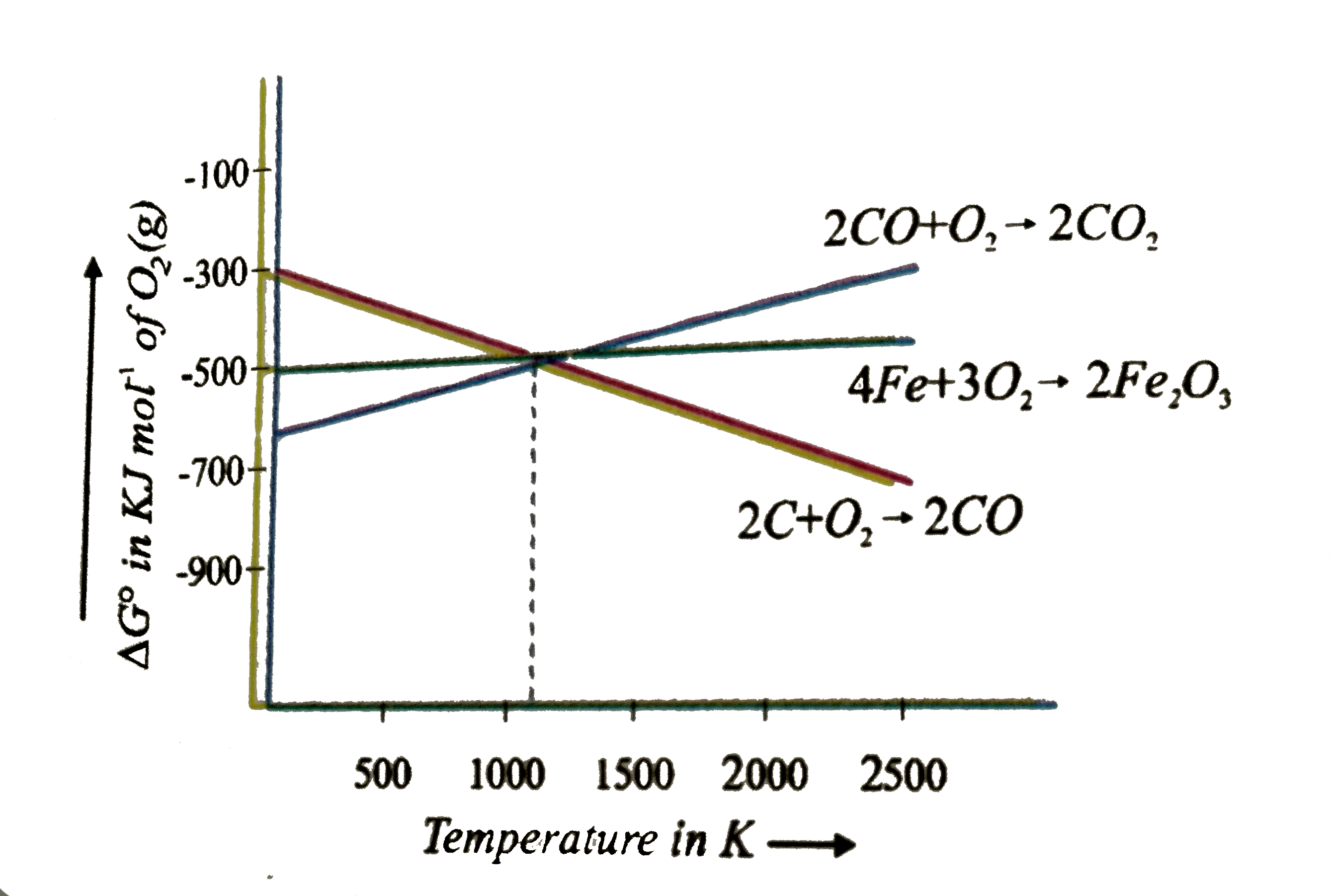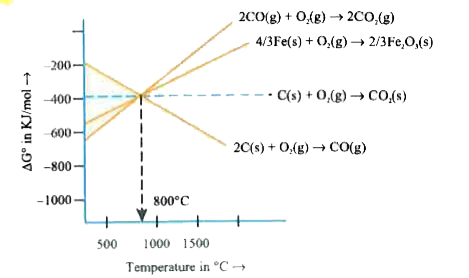Below 1623K,Al can reduce MgO to Mg, but above 1623K, reverse is true.
The correct Answer is:F
Below 1623K, the ΔfGӨ of MgO is lower than that of Al2O3 and hence Mg can reduce Al2O3 to Al , but above 1623K,ΔfGӨ of Al2O3 is lower than that of MgO and hence Al can reduce MgO to Mg.
Topper's Solved these Questions
- BOOK - CENGAGE CHEMISTRYCHAPTER - GENERAL PRINCIPLES AND PROCESS OF ISOLATION OF ELEMENTSEXERCISE - Archives (Linked Comprehension)3videos
GENERAL PRINCIPLES AND PROCESS OF ISOLATION OF ELEMENTS
- BOOK - CENGAGE CHEMISTRYCHAPTER - GENERAL PRINCIPLES AND PROCESS OF ISOLATION OF ELEMENTSEXERCISE - Archives (Multiple Correct)5videos
GENERAL PRINCIPLES AND PROCESS OF ISOLATION OF ELEMENTS
- BOOK - CENGAGE CHEMISTRYCHAPTER - GENERAL PRINCIPLES AND PROCESS OF ISOLATION OF ELEMENTSEXERCISE - Exercise (Fill In The Blanks)30videos
GENERAL PRINCIPLES AND PROCESS OF ISOLATION OF ELEMENTS
- BOOK - CENGAGE CHEMISTRYCHAPTER - ELECTROCHEMISTRYEXERCISE - Archieves Subjective35videos
ELECTROCHEMISTRY
- BOOK - CENGAGE CHEMISTRYCHAPTER - GRIGNARD REAGENTS AND ORGANOMETALLIC REAGENTSEXERCISE - Exercises Archives (Linked Comprehension)1videos
GRIGNARD REAGENTS AND ORGANOMETALLIC REAGENTS
Similar Questions
Which of the following statements are true :
A→Mg(s)+12O2(g)T1−−→MgO(s)
B→mg(?)+12O2(g)T2−−→MgO(s)
C→mg(g)+12O(g)T3−−→MgO(s)

I : Below 1350∘ Mg can reduce Al2O3
II : Above 1350∘C Mg Will reduce Al2O3
III : Below 1350∘ Al can reduce MgO
IV : Above 1350∘ Al can reduce MgO
V : At 1350∘C there is no change in free energy i.e., ΔG=0
View SolutionCarbon monoxide is more effective reducing agent than carbon below 983K but above this temperature, the reverse is true. How would you explain this ?
View Solution
Knowledge Check
- Question 1 - Select One
Statement I: Al cannot reduce MgO below 1500°C while Al can reduce MgO above 1500°C.
Statement II: Mg is a liquid at less than 1500°C and gas at above 1500°C.AIf both Statement I and Statement II are true and Statement II is the correct explanation of Statement I.BIf both Statement I and Statement II are true but Statement II is not the correct explanation for Statement I.CIf Statement I is true but Statement II is false.DIf Statement I is false but Statement II is true. - Question 2 - Select One
Statement I: Al cannot reduce MgO below 1500°C while Al can reduce MgO above 1500°C.
Statement II: Mg is a liquid at less than 1500°C and gas at above 1500°C.AIf both Statement I and Statement II are true and Statement II is the correct explanation of Statement I.BIf both Statement I and Statement II are true but Statement II is not the correct explanation for Statement I.CIf Statement I is true but Statement II is false.DIf Statement I is false but Statement II is true. - Question 3 - Select One
Statement I: Al cannot reduce MgO below 1500°C while Al can reduce MgO above 1500°C.
Statement II: Mg is a liquid at less than 1500°C and gas at above 1500°C.AIf both Statement I and Statement II are true and Statement II is the correct explanation of Statement I.BIf both Statement I and Statement II are true but Statement II is not the correct explanation for Statement I.CIf Statement I is true but Statement II is false.DIf Statement I is false but Statement II is true.
Above 1073 K, ………… reduces FeO to Fe while below 1073K, …………… reduces Fe2O3 to Fe.
View SolutionCarbon monoxide is more effective reducing agent than carbon below 984 K but above this temperature the reverse is ture. How would you explain this?
View SolutionAssertion. Both C and CO can reduce FeO to Fe but at temperatures above 1073 K it is C which is a better reducing agent than CO while below 1073 K, it is CO which is a better reducing agent than C.
Reason. Above 1073 K, ΔfG∘ for CO from C is more negative than that of FeO from Fe while below 1073 K, ΔfG∘CO2 from CO is more negative that that of FeO from Fe.View SolutionCorrect statements from the graph

I) Above 1073 K,ΔG0 for the formation of F2O3 is less negative than ΔG0 for the formation of CO from carbon
II) Above 1073K, Carbon can reduce Fe2O3
III) Below 1073K, CO can reduce Fe2O3
IV) In blast furnance, reduction of Fe2CO3 occurs in different temperature ranges with below 1073K by CO (or) above 1073 K by carbonView SolutionCorrect statements form the graph

I) Above 1073K, ΔG0 for the formation of Fe2O3 is less negative than ΔG0 for the formation of CO from carbon
II) Above 1073K, Carbon can reduce Fe2O3
III) Below 1073K, CO can reduce Fe2O3
IV) In blast furnace, reduction of Fe2O3 occurs in different temperature ranges with below 1073K by CO (or) above 1073K by carbonView Solution

